Contributory members are able to log private notes and comments about each site
Sites Anne T has logged. View this log as a table or view the most recent logs from everyone
Thunder Stone (Shap)
Date Added: 26th Sep 2016
Site Type: Natural Stone / Erratic / Other Natural Feature
Country: England (Cumbria)
Visited: Yes on 5th Jul 2014. My rating: Condition 4 Ambience 4 Access 4
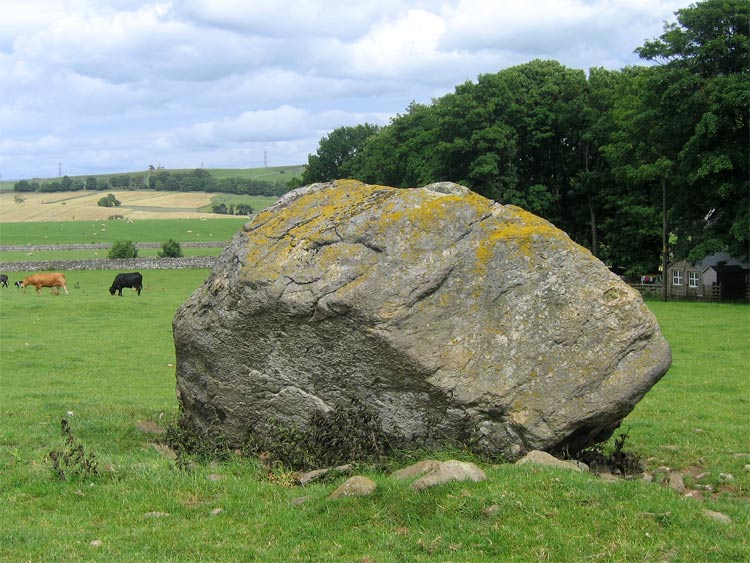
Thunder Stone submitted by LivingRocks on 7th Jul 2005. The enormous Thunder Stone, the largest stone of the Shap Avenue.
(View photo, vote or add a comment)
Log Text: Return visit 5th July 2014: We recently obtained the farmer's permission to walk across the fields to look at any of the Shap Row Stones on his land. Having woken up after a night of heavy, heavy rain to grey skies, we hopped in the car and went over to the Lake District, where the forecast was much better, having spent half an hour researching the exact position of the stones near Shap Village from a map the Shap Local History Society website (well worth a visit to get further information).
The Thunder Stone field was commanded (literally!) by a young bull who was very protective of his cows and calves, and made a move for us the minute we opened the gate, so we backed off (the farmer did warn us he had a bull in the field, but some bulls can be quite placid if kept at a distance). Having come all this way, I didn't want to go away without a picture, so walked up the farm track in front of High Buildings Farm House and round the back of the barns, to get a photograph from the gate to the field.
There is a smaller stone within this same field, so when we go back to Shap in the autumn, once the undergrowth has died back more), we'll visit again to get some more photographs.
First visit 28th June 2014: We went to have a look at some of the stones in Shap Stone Row, but found it almost impossible to park on the very narrow lanes around Keld. I was curious to see The Thunder Stone, and we managed to squeeze our car into the road junction leading down to Shap Abbey and walked back to look at the stone. It lies within a private field, and a clear view was difficult. I have since written to the landowner to ask for permission to get into the field to take photographs, so I'll see what comes back. There is a footpath along the far edge of the field the stone is in, but this leads away from the stone, so this was the closest we could get for now.
The stone is a little difficult to make out in the photograph I've submitted, as there was a lot of farming 'clutter' around the stone.
Aspers Field
Date Added: 1st Jul 2014
Site Type: Standing Stone (Menhir)
Country: England (Cumbria)
Visited: Yes on 28th Jun 2014. My rating: Condition 4 Ambience 4 Access 3
Aspers Field submitted by baz on 26th Apr 2003. This stone (at NY558152) lies in the next field to the more well known Goggleby Stone (NY559151), from which I took this picture (with zoom). Both of these stones form a part of the Shap Stone Avenue.
(View photo, vote or add a comment)
Log Text: This stone is within sight of the Googleby Stone, although a little more difficult to access. The gate to access the field is in Keld Lane, but it's difficult to park here, and we were wary about walking in private fields. There were some dog walkers from the nearby caravan park walking in the fields, so we took advantage of a tumbled stone wall to get a photograph of the cup and ring mark.
Having come home and found out the extent of the stone row at Shap, we'll be going back to see more.
The Cockpit
Date Added: 1st Jul 2014
Site Type: Stone Circle
Country: England (Cumbria)
Visited: Yes on 28th Jun 2014. My rating: Condition 3 Ambience 4 Access 3
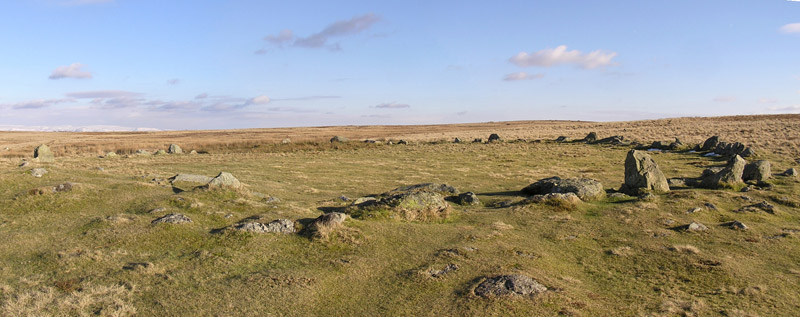
The Cockpit submitted by LivingRocks on 18th Mar 2005. A panoramic view of the Cockpit Stone Circle which according to Magicmap ‘includes a circular kerbed stone bank 2.8m -11.2m wide and up to 0.5m high which encloses an area approximately 27m in diameter. There are 27 (?) standing and recumbent stones set largely into the internal face of this bank, thereby creating the stone circle. The tallest standing stone measures about 0.95m high and some of the recumbent stones are up to 1.9m in length. Within the eastern side of the stone circle, abuttin...
(View photo, vote or add a comment)
Log Text: Almost at the course of High Street Roman Road, there is a view of Ullswater from the footpath just below the Cock Pit Stone Circle.
As the circle is on a good footpath, most of the people stopped at the circle. It's always nice to see people appreciate ancient sites, but I had to wait quite a while to get take photographs without anyone else in it! We found a couple of the outlying stones, and identified a couple of cairns nearby, but couldn't get good enough photographs to make these out properly.
By standing just below the circle, on the main footpath, it's possible to make out the bank.
Well worth a visit, and the view of Ullswater and Pooley Bridge below was worth the easy walk.
Swinside
Date Added: 7th Jul 2014
Site Type: Stone Circle
Country: England (Cumbria)
Visited: Yes on 5th Jul 2014. My rating: Condition 4 Ambience 5 Access 3
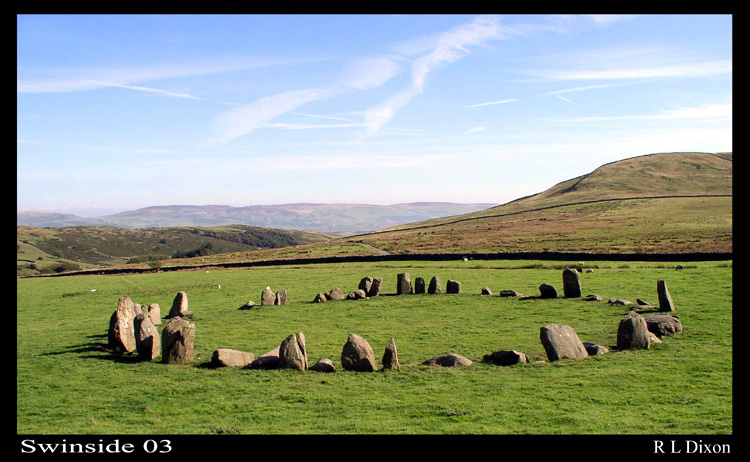
Swinside submitted by rldixon on 15th Jan 2006. Swinside well worth the walk
(View photo, vote or add a comment)
Log Text: After an afternoon spent visiting the Shap Stone Row, my husband was particularly keen to see Swinside Stone Circle, so we took an additional hour to travel to this site. I have to say it was well worth the visit, and I would very definitely go again.
We parked in a small layby just down from Cragg Hall and walked up the marked public bridleway to Swinside (Sunkenkirk) Stone Circle. The first part of the track was steep, but concreted and thankfully short; the rest of the walk was relatively level and had magnificent views. Visibility during our visit was amazing, and we estimated we could see a good 30 miles to the eastern lakes in the far distance. The tide was out, but we had a good view of (what I am assuming from my limited map reading skills!) Duddon Sands in the estuary below until the land levelled out and we could see the circle in the far distance ahead of us.
Surprisingly, we were passed by two separate cars heading up to the farmhouses further up the track - what a remote, but very lovely place to live.
The circle surpassed my expectations. It had a wonderful atmosphere, and I would happily have stayed there until sunset, which, being summer, was a good 5 or 6 hours away, and sadly we had to get home the same evening.
My photographs aren't as good as some of the ones already on the Portal website, so in the images I've submitted, I've tried to pick out some of the features which stood out for me, which include the portal stones at the entrance to the circle.
On reflection, I think we should have climbed up Swinside Fell to get a distant shot of the circle, which would have completed my album for the circle. Next time.
Just to note that in the fields to either side of the bridlepath (particularly the right hand side) leading up to the circle, there were a large number of what appeared to be shaped stones, and we wondered if at one time there had been an avenue leading up to the circle. I've submitted a picture of one stone which has a striking resemblance to the stone in the circle with the quartz banding across it.
Kemp Howe
Date Added: 7th Jul 2014
Site Type: Stone Circle
Country: England (Cumbria)
Visited: Yes on 5th Jul 2014. My rating: Condition 2 Ambience 2 Access 4

Kemp Howe submitted by nicoladidsbury on 29th Mar 2004. This is the remains of what must have been a beautiful stone circle. The stones are pink granite and have a lovely glow. Unfortunately the ambience has been shattered by the "wonderful" victorians, who built the railway on top of it.
(View photo, vote or add a comment)
Log Text: Having been kept awake most of the night by heavy, heavy rain, then being greeted by leaden skies with a distinctly autumn feel, the weather in Cumbria, according to the weather forecast, seemed a lot more appealing.
Armed with information from the Portal and a map with the locations of stones in the Stone Row from the Shap Local History Society, we hopped in the car and drove west.
We parked at the entrance to the field with Kemp Howe in it (the gate to the field was left wide open, and there was a short trackway up to the stones, although the road was horrendously busy), and walked the 100 feet or so up to the stones. Whilst the grass in the field had recently been cut, the undergrowth round the stones had been left uncut.
I confess to being horrified at the damage done to these stones by the Victorians - what a travesty. We got to admire several trains passing by at very close quarters, and could almost have waved to the quarry men the other side of the railway line. The views of the fells to the west (across the road) and beyond was appreciated and were in stark contrast with what was behind us.
This marked the start of an afternoon well spent exploring the Stone Row in glorious sunshine, with a nice lunch stop at the Shap Coffee Shop in the village, then taking in the stones at the west of Shap Village, finishing with the Tumulus at Skellow Hill and the Thunder Stone.
Shap Avenue
Date Added: 7th Jul 2014
Site Type: Multiple Stone Rows / Avenue
Country: England (Cumbria)
Visited: Yes on 5th Jul 2014. My rating: Condition 2 Ambience 4 Access 3

Shap Avenue submitted by AngieLake on 3rd Jun 2011. These were the most noticeable stones fringing the east side of the road, heading back towards the village after visiting Kemp Howe, that might have possibly come from the ancient monuments.
(View photo, vote or add a comment)
Log Text: Armed with information from the Portal and a map of the locations of the stones they've mapped in the stone row so far from Shap Local History Society, we started off at Kemp Howe stone circle, and walked round the village looking for stones. We met a couple of the more senior locals as we went round, and they were keen to help and point out where the stones were, and tell us of others. There are so many stones around and near to the village, most of them clearly on the same alignment that we became quite overwhelmed with the scale and sense of what our ancestors achieved and what it all represented.
We ended up at Skellaw Hill and the Thunder Stone, then had to call it a day, as we wanted to travel over to Swinside Stone Circle before heading off home.
The Shap Stone Row is certainly intriguing, and I came back with around 100 photos of possible stones and locations - I've picked two to submit that aren't already recorded on this page.
Well worth exploring, and whilst visiting, I'd also recommend hopping down to Shap Abbey and Keld Chapel nearby, too. Both are free to get into, and are in picturesque locations, with a lot of history attached.
Newbeggin Stone Row
Trip No.9 Entry No.4 Date Added: 15th Feb 2017
Site Type: Stone Row / Alignment
Country: England (Cumbria)
Visited: Visited (still working on) on 12th Feb 2017
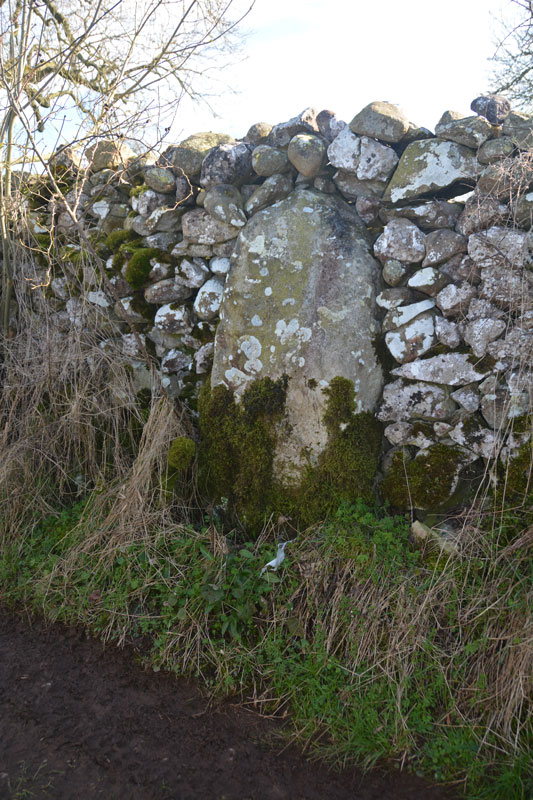
Newbeggin Stone Row (Possible) submitted by Anne T on 28th Mar 2017. This stone is built into a stone wall on a footpath which follows the Carlsike Burn, around Hoghouse Hill to Newbeggin. Located at NY 48058 29531. Note: 3rd April 2017. The Lead Officer for the Historic Environment and Commons says "This is slightly more interesting. I would not like to guess at when this might have been erected."
(View photo, vote or add a comment)
Log Text: Newbiggin Stone Row, near Penrith: See comment on main page. Tried to find. Seen an image of a stone in an enclosure wall but unable to locate. Working on finding exact location and will return!
The Galloway Stone
Trip No.15 Entry No.2 Date Added: 3rd Apr 2017
Site Type: Natural Stone / Erratic / Other Natural Feature
Country: England (Cumbria)
Visited: Yes on 2nd Apr 2017. My rating: Condition 3 Ambience 2 Access 5

The Galloway Stone submitted by Anne T on 3rd Apr 2017. Looking south east over the Galloway Stone to the hills beyond.
(View photo, vote or add a comment)
Log Text: The Galloway Stone, near Orton, Cumbria: Spotted this named stone on the map as we drove towards Orton to find refreshments. There were many other large (but not quite as large as this) stones in the vicinity. With the M6 Northbound carriageway almost immediately behind, and above, this stone, I could have been forgiven for thinking this was left over from building the motorway.
In close up, the stone is clearly pink Shap granite, and had a red tint in the sunlight. A big surprise was find the bench mark with its large rivet on top of the stone.
Irthington Motte
Trip No.40 Entry No.3 Date Added: 24th Aug 2017
Site Type: Misc. Earthwork
Country: England (Cumbria)
Visited: Yes on 20th Aug 2017. My rating: Condition 2 Ambience 3 Access 5
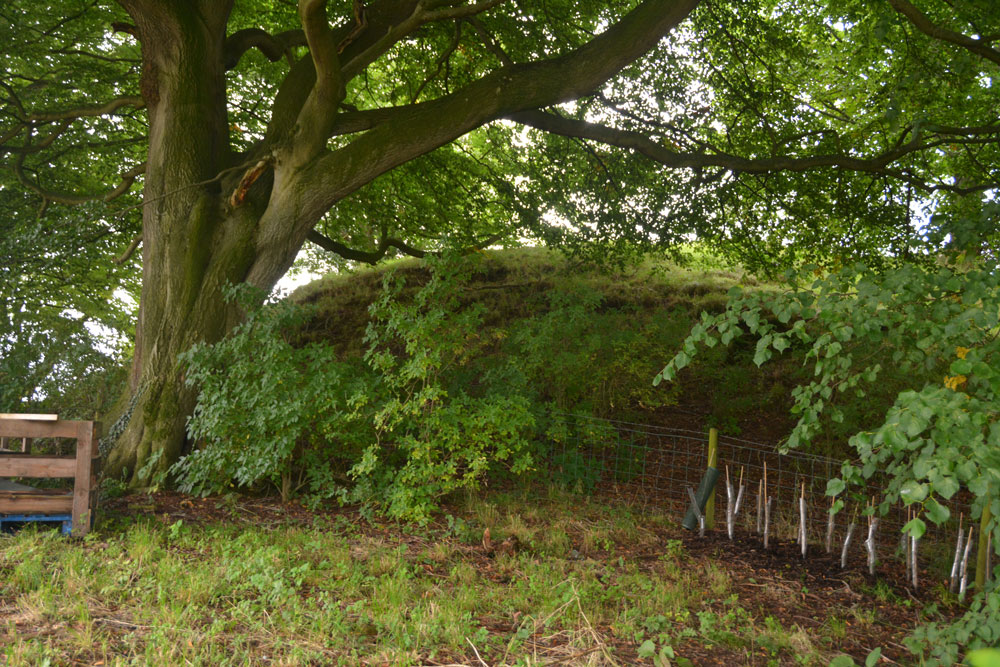
Irthington Motte submitted by Anne T on 24th Aug 2017. Leaning over the fence from the builder's yard, the oval of this earthwork was more obvious. I would have liked to have gone in to the yard for a closer look, but there was a lot of rubble, heavy equipment and a padlocked gate.
(View photo, vote or add a comment)
Log Text: Irthington Motte, Cumbria: We continued walking down the lane which leads to the River Irthing. At first, nothing appeared to stand out as a motte, then I realised that the mound behind the fence, sitting between the farm and the builder’s yard was actually the motte.
Walking down nearer to the entrance to the builder’s yard, the shrubbery was less intrusive and the oval shape of the motte became more apparent.
I would have liked to have gone into the builder’s yard but there was so much rubble, heavy equipment and a padlocked gate. No-one in the farm yard to ask, despite several cars being around.
Tullie House Museum
Trip No.46 Entry No.1 Date Added: 19th Sep 2017
Site Type: Museum
Country: England (Cumbria)
Visited: Yes on 18th Sep 2017. My rating: Condition 4 Ambience 2 Access 4
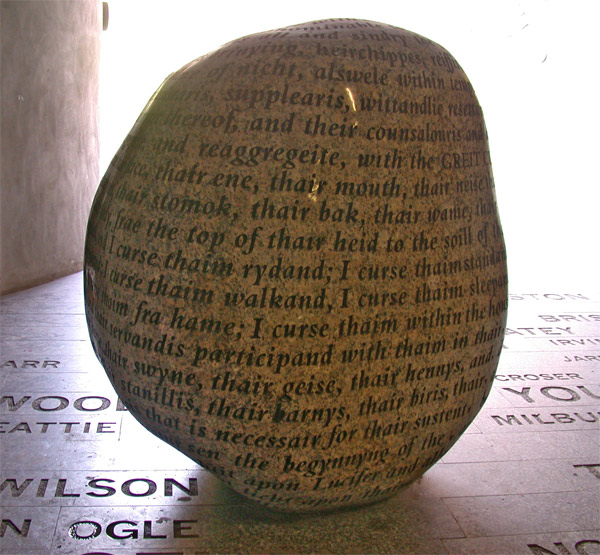
Tullie House Museum submitted by nicoladidsbury on 13th Mar 2005. Cursing Stone, Tullie House Millenium Walkway, Carlisle
The polished granite stone is inscribed with the curse, which was cast on all the reivers of the English/Scottish borders in the 16th Centuary.
The names of those reivers are inscribed in the stones that make up the floor of the millenium walkway, Armstrongs, Grahams, Robsons, Elliotts, and Kerrs to made a few.
The Tullie House Museum has a 10-minute wide-screen audio-visual spectacular which gives a dramatic impression of the lawles...
(View photo, vote or add a comment)
Log Text: The Cursing Stone, Carlisle: This stone is located in the strangely lit underpath that runs the dual carriageway near Tullie House Museum and Carlisle Castle, next to Tullie House museum. We came across this quite by chance, thinking it was located inside the museum. It is actually on the Tullie House side of the pedestrian underpass from the Castle to the Museum.
There is nothing on the walls of the underpass to tell you what this stone is. I’d read about it on the Portal some time ago and recognised it. The wording of the curse is recorded below.
Snuff Mill (Stainton)
Trip No.60 Entry No.1 Date Added: 24th Nov 2017
Site Type: Standing Stone (Menhir)
Country: England (Cumbria)
Visited: Yes on 20th Nov 2017. My rating: Condition 3 Ambience 3 Access 5

Snuff Mill (Stainton) submitted by Anne T on 24th Nov 2017. First view of the stone from across the road. The dry stone wall behind and to the north eastern side of the stone has been dog-legged around it, indicating the stone was here well before the wall.
(View photo, vote or add a comment)
Log Text: Snuff Mill Standing (?) Stone: On the way back from Pooley Bridge to Stainton and Newbeggin, I saw a standing stone by the side of the road (A592) so Andrew turned around and we parked in the driveway of Snuff Mill Water Treatment Centre. The stone was just passed a corner of this busy little road, and it felt quite dangerous as none of the cars moved very far out of the way for us walkers.
The dry stone wall had been ‘kinked’ to go around the stone. It was heavily covered in moss.
I can’t find anything about it on Pastscape or Historic England, so will email Mark Brennand at Cumbria County Council.
Mossthorn Long Cairn 2
Trip No.60 Entry No.4 Date Added: 24th Nov 2017
Site Type: Cairn
Country: England (Cumbria)
Visited: Saw from a distance on 20th Nov 2017. My rating: Condition 2 Ambience 3 Access 3
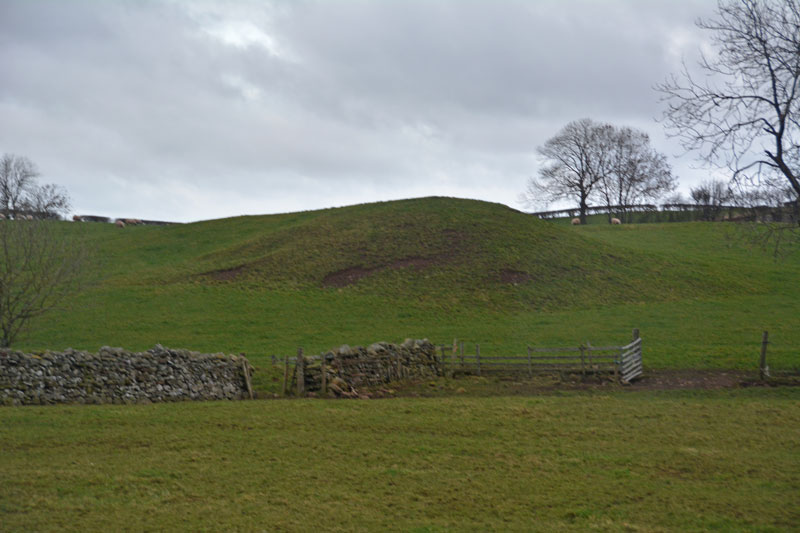
Mossthorn Long Cairn 2 submitted by Anne T on 13th Feb 2017. The long cairn at grid reference NY 48289 30440, taken from the layby outside The Wreays on the minor road from the A66 to Greystoke.
(View photo, vote or add a comment)
Log Text: Mossthorn Long Cairn 2, Copt Howe, Newton Reigny: See the visit report for Mossthorn Long Cairn 1 for more details. This is the side of the long cairn (or natural feature, as Pastscape says?) we couldn’t see from the road on our last visit on 12th February 2017. This time, we could only see it from the field boundary near the southern end of Mossthorn Long Cairn 1. From this angle, it does look like a natural hummock, although more like a cairn from the main road.
King Arthur's Round Table
Trip No.68 Entry No.8 Date Added: 7th Apr 2018
Site Type: Henge
Country: England (Cumbria)
Visited: Yes on 5th Apr 2018. My rating: Condition 3 Ambience 4 Access 5
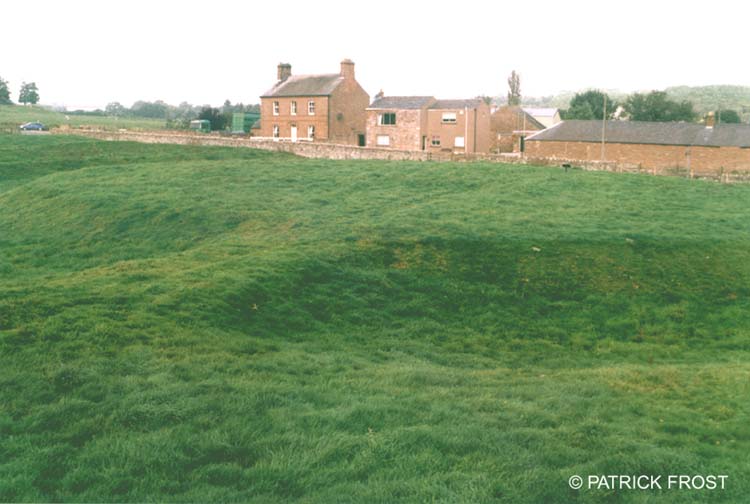
King Arthur's Round Table submitted by Patrick Frost on 14th Oct 2002. King Arthur's Round Table in Cumbria.
(View photo, vote or add a comment)
Log Text: King Arthur's Round Table Henge, Eamont Bridge: We tried to stop here on the way down to Langwathby, but the traffic was so dense and moving in so many different directions at the traffic lights, we decided to try when it was quieter. Thankfully, we managed to park in the layby opposite on the way back and let ourselves in through the kissing gate by the western side of the A66.
The scale of this monument is huge, and we walked all around its outer bank, trying to photograph the whole. Well worth stopping off and taking a look.
I didn't realise until I got home and was looking up information that there is a Little Round Table henge at NY 52387 28180.
Castlesteads (Lowther)
Trip No.68 Entry No.6 Date Added: 10th Apr 2018
Site Type: Misc. Earthwork
Country: England (Cumbria)
Visited: Yes on 5th Apr 2018. My rating: Condition 2 Ambience 4 Access 4
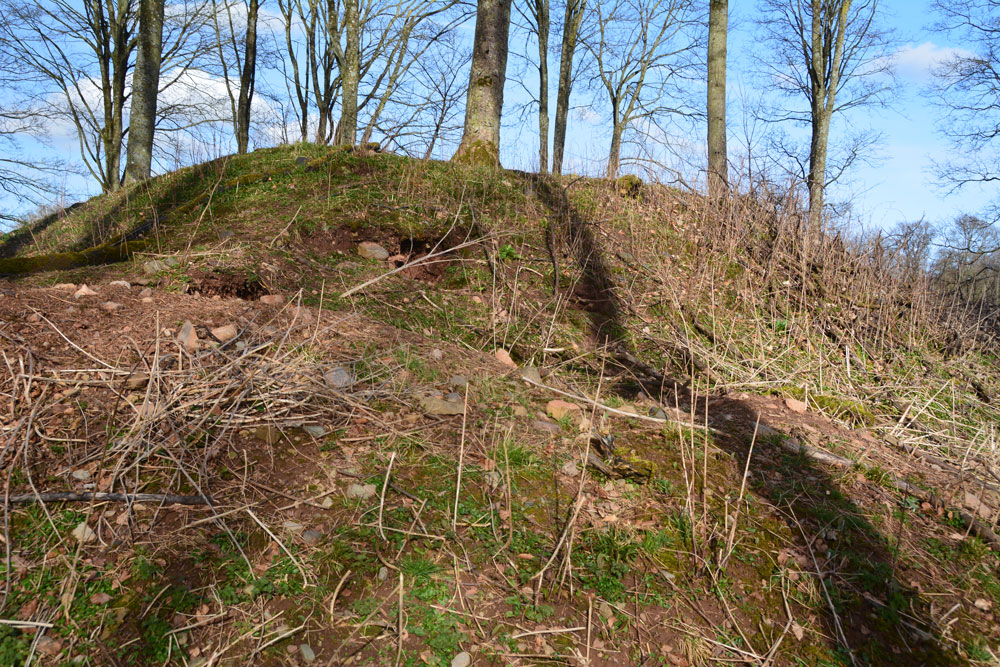
Castlesteads (Lowther) submitted by Anne T on 10th Apr 2018. Approaching the earthworks from its north western side. The bank rises rapidly from the River Lowther below. It's a very strategic spot on a curve of the river.
(View photo, vote or add a comment)
Log Text: Castlesteads Earthworks, Lowther Castle: This Castlesteads (as opposed to the Iron Age settlement we visited next) is just over 220 metres south of the gate into St. Michael’s Churchyard.
Being on a high spot above a bend in the River Lowther, it looks like a very strategic spot to build a defensive structure. In fact, Pastscape says it’s the remains of an old Pele Tower or other medieval building.
Hidden in the woods, but with a footpath leading to it, it is an intriguing ruin, with high banks on all four sides of a rectangle and remnants of the masonry on its western edge.
Towerbrae Cairn
Trip No.69 Entry No.2 Date Added: 5th May 2018
Site Type: Cairn
Country: England (Cumbria)
Visited: Saw from a distance on 23rd Apr 2018. My rating: Condition 2 Ambience 3 Access 4

Towerbrae Cairn submitted by Anne T on 5th May 2018. This very blurry photograph was taken from the road just north of Luke's Cottage. We had planned to walk up to the cairn, but moments later a heavy downpour sent us up to the Bewcastle Cross instead.
(View photo, vote or add a comment)
Log Text: Towerbrae Cairn, Near Bewcastle: We stopped on the road to St. Cuthbert's, Bewcastle to find out how to walk to this cairn, which was basically up a quad bike track just south of Luke's Cottage. As there was nowhere near to park on a grass verge, we decided to go onto try and find Priest's Well at Bewcastle and stop on the way back.
The weather intervened, and a heavy downpour and heavy black clouds stopped us from doing this walk, but we will come back again.
The cairn is highly visible in the landscape. Apparently there is a modern marker on the cairn, and I'd like to complete our trip by returning soon.
Castlehowe Scar Stone Circle
Date Added: 8th Sep 2014
Site Type: Stone Circle
Country: England (Cumbria)
Visited: Yes on 7th Sep 2014. My rating: Condition 3 Ambience 4 Access 5
Castlehowe Scar Stone Circle submitted by baz on 3rd May 2003. Castlehowe Scar Stone Circle (NY587155).
Ten stones form this small stone circle which is now huddled up against a drystone wall, in a field with a locked gate. On the other side of the wall, there appears to be a stone row.
(View photo, vote or add a comment)
Log Text: Castlehowe Scar Stone Circle, near Shap, Cumbria: Having previously stopped at the Thunder Stone 200 metres to the west of Castlehowe Scar Farm, we drove almost 1 kilometre up to this little stone circle. All the land from the Thunder Stone up to Castlehouse Scar Wood on the right hand side of the road is labelled as access land on the Ordnance Survey maps. Immediately before the wood there is a single track metalled road, which turns right towards Hardendale Quarry, with room for 2-3 cars to park on the verge next to the field containing the stone circle.
Whilst the land is labelled access land, there was a padlock on the gate to the field, so we explored from the field next door, where there seemed to be a few red granite stones poking up through the grass in the field. ‘A stone row’, my husband pronounced.
Having driven over 60 miles to get here, and having checked that the field really was access land, in frustration we ended up climbing over the gate to walk quickly round this small stone circle (this is in complete contrast to the farmer at the Gamelands Stone Circle, near Orton, who had very kindly put in a kissing gate to allow entry). There was a water container left close to the stones by the farmer, and I was sorely tempted to try and move this out of the way to avoid it spoiling the photographs, but didn’t dare (and I suspect I would have needed a tractor to attempt it).
All the stones were red Shap granite – we wondered after if they had been polished at some stage in the past to make them shine. The red of the granite certainly stood out amongst the white/grey of the natural limestone bedrock nearby. Checking on the geology of the area when we got home, these red granite stones seem to only came from a very small area, so any of these red stones would have needed to have been quarried and moved up to their current locations.
Strangely, to me, the size of the stones seemed large in comparison to the diameter of the circle, as they did what remained of Kemp Howe at the edge of Shap Village.
Whilst we were parked at Castlehowe Stone Circle, there were many cars coming and going – dog walkers, people doing outdoor activities (we thought they might be cavers) and the owner of the wood next door. Curious that so many people were around, but no-one took any notice of the stone circle, apart from us – perhaps they are all too familiar with it.
We next drove on to Iron Hill, further down the minor road running alongside Castlehouse Scar Wood to Hardendale Quarry to continue our Stone Circle and Cairn adventure.
Gamelands
Date Added: 8th Sep 2014
Site Type: Stone Circle
Country: England (Cumbria)
Visited: Yes on 7th Sep 2014. My rating: Condition 3 Ambience 4 Access 4
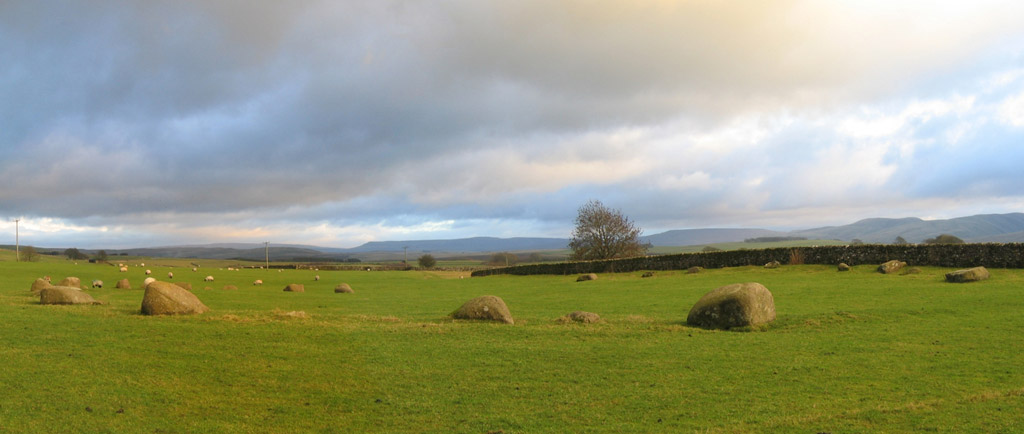
Gamelands submitted by LivingRocks on 8th Feb 2005. Photographed in November 2004 with short grass, a superb site even though the stones are all fallen.
(View photo, vote or add a comment)
Log Text: Gamelands Stone Circle, near Orton, Cumbria: By now, it was late afternoon, with the evening rapidly approaching, and almost time to head off home. From the Oddendale Cairns and Stone Circle we headed off in search of something to eat and drink before finding Gamelands. In Orton, we found the Chocolate Factory still open and busy, so stopped off for very welcome refreshments.
I found navigating to this stone circle tricky, as it’s on the edge of two map sheets, so we took the wrong road out of Orton before identifying the right minor road, signposted to Raisbeck. Following the B6261 past a minor crossroads just out of Orton village (the left hand side being Street Lane), the B road shortly afterwards turns to the right; the minor road needed to get to Gamelands Stone Circle carrying straight on to Knott Lane, signposted as ‘Public Byway leading over Knott Green to Public Bridleway’. Knott Lane is about 1 mile east of Orton. When we visited, there was a large pile of stones, being used to repair the bridleway blocking part of the entrance, but the minor road was wide enough (just) to bump up onto the grass verge and leave the car to walk up Knott Lane.
As we walked up the bridleway, we didn’t see the stone circle until we were almost upon it. The farmer has put in what looks like a relatively new wooden kissing gate to let people access the field, which was refreshingly nice. Thank you, Mr. Farmer! This is one of the largest stone circles we’ve seen in this area; the Visit Cumbria website tells me that this circle is some 100 yards in circumference.
All the stones have fallen, and it must have been impressive when they stood upright. This stone circle (oval) is certainly in a lovely location and very tranquil. It is situated on a plateau immediately below the impressive Knott Scar which rises up to the North, with spectacular views over the Eden Valley and the North Pennines.
I got to see at close hand how the Shap Red Granite is made up – with large ‘tabular’ feldspar crystals glinting out from the whole. My husband has seen this type of granite polished and used in construction projects/buildings, and if our ancestors did polish these stones, then this circle must have been fantastic when it was created.
After spending some time here, just soaking in the atmosphere, we left to go home, with one final stop, at Raise Howe Tumulus, which was on our way home. A glorious afternoon, very well spent.
Thunder Stone (Castlehowe Scar)
Date Added: 9th Sep 2014
Site Type: Natural Stone / Erratic / Other Natural Feature
Country: England (Cumbria)
Visited: Yes on 7th Sep 2014. My rating: Condition 3 Ambience 3 Access 4
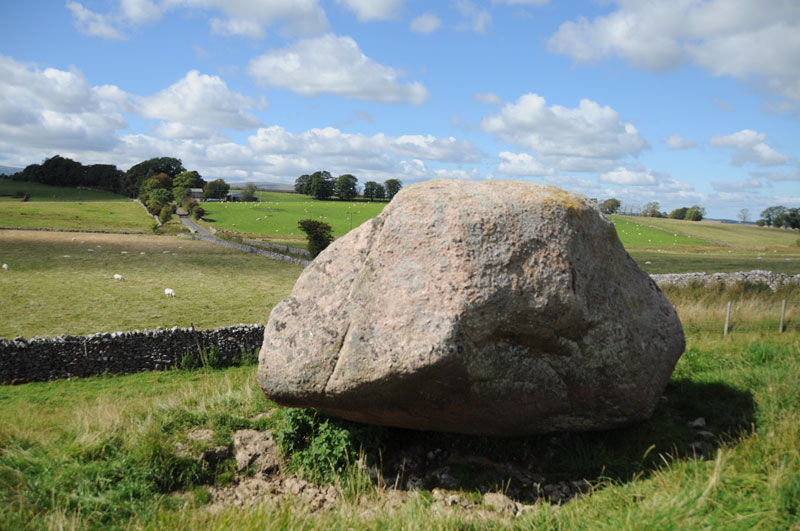
Thunder Stone (Castlehowe Scar) submitted by Anne T on 8th Sep 2014. Another face of this Thunder Stone. The red of the Shap Granite can be clearly seen in the strong sunlight.
(View photo, vote or add a comment)
Log Text: Thunder Stone (Castlehowe Scar), near Shap, Cumbria: When my husband suggested going back to Shap, I groaned inwardly - another day of walking round searching for stones within the village? But I was in for a great surprise. Andrew had identified stone circles and cairns within a few miles of each other, and we had a great afternoon.
On our way to Castlehowe Scar Stone Circle, I spotted two thunder stones marked on the map near Castlehowe Scar Farm on the way to the circle.
From Junction 39, Shap Interchange on the M6, turning right to drive through Shap Village, we took the right hand turn leading to Crosby Ravensworthjust after the Fire Station on the left, and immediately before the chip shop. This road looks as if it is leading into a housing estate, but it does go onto other villages.
Just after passing over the cemetery on the right hand then, then going over the two bridges over the M6 carriageways, I spotted the first of the Thunder Stones, and we stopped on the road for me to take a few photographs. There seem to be so many other erratics in this area, that by the end of the afternoon, I became a little immune to them! This one stood out at the right hand side of the road, perched on the edge of a small quarry. A footpath leading to Hardendale gives access onto the field and it’s possible to go and walk round three sides of the stone (four if you don’t mind heights). It looks as if it is made of Shap granite and in the strong sunlight the red of the Shap Granite stood out beautifully.
[But since the visit, I'm left wondering if this stone is an erratic, as the quarry seemed to be limestone, and the Thunder Stone red Shap granite. Was this stone deliberately brought up the valley to form part of a row to the stone circle? The complexity of the monuments around Shap is quite mind-blowing, especially after our day wandering around some of the gems around Shap.]
Having taken my photographs, we went onto the Castlehowe Scar Stone Circle which is less than one kilometre east of this stone.
Raise Howe Cairn
Date Added: 9th Sep 2014
Site Type: Cairn
Country: England (Cumbria)
Visited: Yes on 7th Sep 2014. My rating: Condition 2 Ambience 3 Access 5
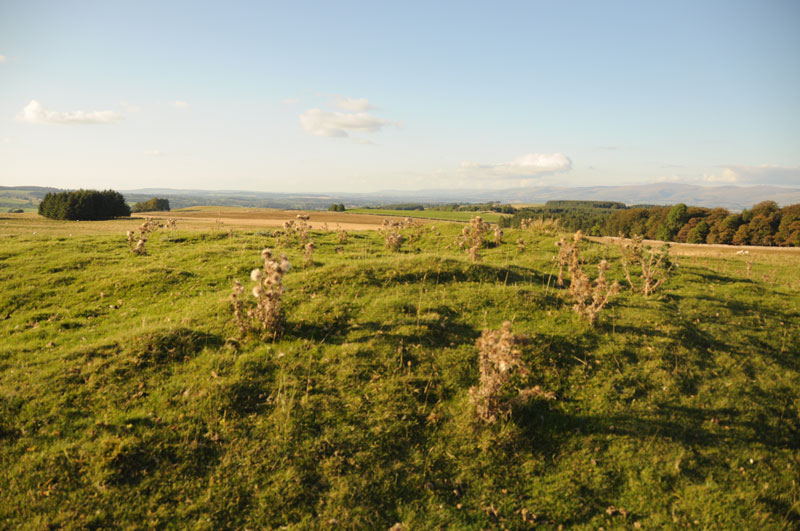
Raise Howe Cairn submitted by Anne T on 9th Sep 2014. Standing on top of Raise Howe Cairn looking north/north-east with Maskriggs Wood at the top right hand side of the picture.
(View photo, vote or add a comment)
Log Text: Raise Howe Cairn, Cumbria: From Gamelands Stone Circle, 1 km east of the village of Orton, we drove back into the village and found the B6260 which heads over the moors towards Crosby Ravensworth and Appleby-in-Westmorland. The road climbs steeply from Orton, leading up onto Orton Scar, Beacon Hill and Gaythorpe Plain. We stopped quickly to see if we could see Gamelands within the context of the landscape, but it seemed to be hidden within a dip beneath Knott Hill in the distance.
The B6260 is a very fast road and once on moorland we needed to be careful of the sheep meandering at the side (and sometimes across) the road. At first glance, you might be forgiven for thinking that Raise Howe Cairn is just a spoil heap next to a quarry, but parking on the verge opposite and walking up to the cairn, its shape and function become apparent. Limestone rubble appears under the soil and turf, and at the top of the mound, there are humps and bumps which make it appear as if the mound has been excavated (although the English Heritage Pastscape records say it has not been).
Our first reaction was “what a spot to be buried in” – there are 360 degree views all around and the landscape as a whole seems too large to take in. The Scale Beck valley lies to the east, the Lyvennet Beck valley to the west and the river Lune in the distance to the south.
Having checked the English Heritage records on my return home, they tell me this is a turf covered, slightly mutilated oval mound of earth and limestone rubble up to 1.2 high, maximum dimensions 23m x 18m and dates from the Bronze Age.
This seems to be a popular picnic spot as there was a lot of rubbish lying around, and a sign next to the quarry says ‘no motor vehicles’ as if someone might drive over the edge of the quarry face.
Not particularly a place to travel to just to see the cairn, but well worth stopping to appreciate the beauty of the landscape and the burial practices of our ancestors.
Kalmott cairn circle
Date Added: 9th Sep 2014
Site Type: Ring Cairn
Country: England (Cumbria)
Visited: Yes on 7th Sep 2014. My rating: Condition 3 Ambience 3 Access 4
Kalmott cairn circle submitted by VapourTrail on 28th Sep 2009. Kalmott cairn on a typically dull Cumbrian day in September.
(View photo, vote or add a comment)
Log Text: Kalmott Cairn Circle, Oddendales, Cumbria: Arriving at Oddendales to see the cairns marked on the OS map, just past the footpath sign pointing us to the Coast-to-Coast/Crosby Ravensworth, we were surprised to come across what appeared to be a small cairn with a ring of stones with a central cluster. It’s not marked on the Ordnance Survey maps.
Sitting between the stone wall of Oddendales Farm on the left and the modern trackway we were walking on, it seemed surprising that this cairn had survived intact. Not been able to find out any more about it, which has been frustrating. I record a photograph here to show what we saw. I’ve now only just found a photograph and brief description about this on Hedge Druid's web site; Hedge Druid says he then submitted it to the Portal for inclusion.
Having taken a couple of photos, we then made our way up to Seal Howe Cairn.
